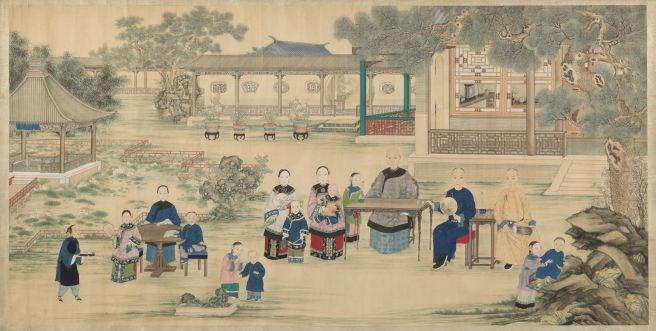
In Europe, there are several formalized traditions of botanical garden design including the Dutch, English, French, Greek, Italian, and Spanish. In Asia, there are at least long-established Chinese, Japanese, Korean, and Persian schools and May being Asian Pacific American Heritage Month, I’m focusing on Los Angeles’s Asian-style gardens.

The tradition of Japanese-American nurseries stretches back to the 1850s when Japanese immigrants began establishing them in California. Takanoshin Domoto began importing azaleas, camellias, carnations, chrysanthemums, lilies, and wisterias in the 1880s. The California Flower Growers Association was formed by Japanese-Americans in 1906. The European vogue for Japanese art and design began at least as early as the 1860s and continued into the early 1900s when some wealthy westerners created their own Japanese-inspired gardens. In the 1920s and 1930s, Japanese gardens flourished amongst Los Angeles’s social elite and were believed by some to have the power to lessen the rising tide of anti-Japanese racism then faced by many Japanese-Americans as they moved into previously all-white suburbs.
Many Japanese-Americans first worked in agriculture, in particular raising strawberries. In 1904, 24 Japanese farmers were leasing land on which to grow the sweet, red fruit. Other Japanese raised flowers and in 1906, Japanese gardeners formed the California Flower Growers Association. Downtown’s Flower Market opened, in 1913, as the Japanese Market. Aside from the Japanese Internment (1942-1946) Japanese-Americans dominated not only the floral and gardening trade, but the landscaping one as well, into the late 1960s, around the time the gasoline-powered leaf blower transformed landscaping into an artless, obnoxious, pointless, and Sisyphean “blow-and-go” nuisance.

There are still signs of Asian influence on Southern California lawns whether they be the Buddhas, shi, and tōrō which share yard space with gnomes and pink flamingos; the occasional, carefully sculpted shrub; or the five gallon Pearl River Soy Sauce bucket containing a money tree placed on an apartment staircase.
Obviously, I’m not going to make a directory of every private patio jungles, backyards, nor attractive but fenced off parks such as the small but pretty one in front of the LA Korean Festival Foundation‘s Koreatown headquarters. Nor is this directory limited to purely public spaces — but all are open to the public. As always, corrections and additions are welcome.
JAPANESE GARDEN and CHINESE GARDEN (San Marino)
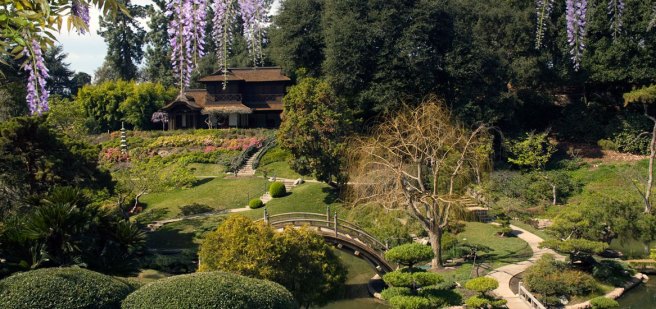
The Huntington Library, Art Collections and Botanical Gardens were founded by railroad magnate and art collector Henry E. Huntington. The Japanese Garden was created in 1912 and opened to the public in 1928. Within the garden is a Japanese home (shipped to the garden from Japan in 1904) a teahouse (built in Kyoto in the 1960s), a bonsai collection, the moon bridge (built by Toichiro Kawai), and a zen court and has been used to portray Japan in films like Beverly Hills Ninja.

The Chinese Garden’s Chinese name is 流芳園 (or, “garden of flowing fragrance”). It’s among the largest Chinese gardens outside of Asia. It was made in collaboration between architects and artisans from Suzhou and local builders and gardeners. It opened in 2008.
Both gardens and all of the Huntington are worthy of frequent visits although San Marino is underserved by public transit. Metro‘s 177 stops 1.75 kilometers away at the campus of the California Institute of Technology and their 177, 180/181, 687/686, Rapid 780, and Foothill Transit‘s 187 lines all stop about 2.5 kilometers north at the campus of Pasadena City College.
YAMASHIRO (Hollywood Heights)

Yamashiro was originally designed by architect Franklin Smalls as the private residence of cotton importers Charles and Adolph Bernheimer, built between 1911 and 1914. It was supposedly modeled after a fortress the brothers saw near Kyoto. The following year, the Panama-California Exhibitions in San Diego and San Francisco further promoted the aesthetics of Japanese gardens. The brothers sold the estate in 1924 and built another Japanese-inspired estate in Pacific Palisades, which before long slid into the ocean. Yamashiro and the Bernheimer Gardens passed through several hands, serving as a clubhouse, event space, school, and apartments until 1960, when Thomas Y. Glover began its transformation into a bar, then a restaurant. It’s served by Metro’s 156, 212/312, 217, 222, and Red lines.
STORRIER STEARNS JAPANESE GARDEN (Pasadena)
The Storrier Stearns Japanese Garden was designed by Kinzuchi Fujii, who was hired by Charles and Ellamae Storrier Stearns to create a private Japanese Garden in their West Pasadena home. The undertaking lasted from 1935 to 1942 when, like all Californians of Japanese descent, he was taken to a concentration camp. The .59-hectare grounds of the garden boast a five-meter tall waterfall, a cedar waiting house, two interconnected ponds, and a teahouse named Niko-an (“Abode at Two Ponds”). Fuji, who died in 1957, designed many Japanese gardens in Southern California but the Storrier Stearns Japanese Garden is his only creation which remains. The original teahouse burned down in 1981. Under the direction of landscape architect Takeo Uesugi, the garden was restored from 2007-2013, including a reconstruction of Niko-an based on Fuji’s original drawings, photographs, and architectural plans. Today it’s open to the public every Thursday and the last Sunday of every month.
The Storrier Stearns Japanese Garden is served by Metro’s 260, 687/686, and Rapid 762 lines as well as Pasadena Transit‘s 20 line. The nearest train station, Fillmore Station, is located 1.3 kilometers away.
HEIWA EN (Boyle Heights)
In the 1910s, the growing Japanese population of Little Tokyo spread along East 1st Street into Boyle Heights (and later, City Terrace). By the 1920s, Boyle Heights was the third largest Japanese enclave after Little Tokyo and Furusato on Terminal Island. As Japanese moved into neighborhoods where few Japanese previously lived, anti-Japanese racism flared. In 1935, led by Shigeo Takayama (president of the Roosevelt High School Japanese Club), Heiwa En (or “Garden of Peace”) was constructed on the campus of Boyle Heights’ Theodore Roosevelt High School. Sadly, it was destroyed during World War II, when all of California’s Japanese were forcibly relocated to concentration camps. Decades later, in 1996, a new version of the garden was reconstructed in close to the original spot.
Located as it is on a high school campus, arrangements presumably have to be made with school officials to visit Heiwa En. Assuming this is possible, Roosevelt High is served by Metro’s 106, 251, 252, and 605 lines.
STONER PARK JAPANESE GARDEN
Stoner Park Japanese Garden, in once-heavily Japanese Sawtelle, got a Japanese garden in 1931. In 1950, it was renovated by Koichi Kawana. He is said, by several sources, to have again redesigned it in 1989, shortly before his death in 1990.
Stoner Park Japanese Garden is served by Big Blue Bus‘s R10, 14, and 15 lines.
ST. FRANCIS XAVIER CHURCH JAPANESE CATHOLIC CENTER GROTTO (Arts District)
The St. Francis Xavier Church Japanese Catholic Center began in 1921. The grotto was designed by Ryozo Kado, who came from Shizuoka-ken to the US in 1910. It’s not clear to me what year the grotto was built but the priests residence and gymnasium were designed by Ray J. Kieffer and built in 1938. A classroom was added the same year. Classrooms and a restroom (designed by O’Leary & Terasawa) were added in 1964. Kado died in 1982.
The St. Francis Xavier Church Japanese Catholic Center is accessible via LADOT’s Commuter Express 439, LADOT’s DASH Downtown A, and Metro’s Gold Line.
HANNAH CARTER JAPANESE GARDEN (Bel-Air) — CURRENTLY CLOSED TO THE PUBLIC

The Hannah Carter Japanese Garden was designed by Nagao Sakurai and built from 1959-1961, inspired by gardens in Kyoto. The .6 hectare garden is named after the wife of Edward Carter, chairman of the Regents of the University of California. It was donated to the University of California, Los Angeles (UCLA) in 1964. UCLA announced its intention to sell the garden in 2011 and began receiving bids in 2012 but the Los Angeles Superior Court granted a temporary injunction halting the sale of the garden and activists are trying to save it. Although currently closed to the public, it is served by Metro’s 2/302, 234, and Rapid 734 lines.
DESCANSO GARDENS’ JAPANESE GARDEN (La Cañada Flintridge)
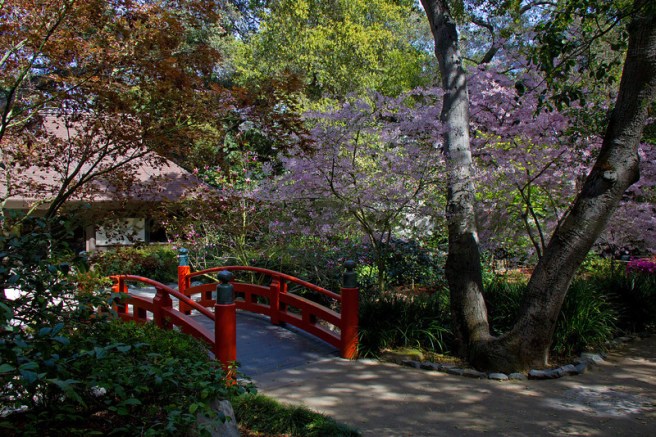
Descanso Gardens is a 61-hectare botanical garden which was formerly the property of newspaper magnate E. Manchester Boddy. He ceded the site to Los Angeles County in 1953. It began as a camellia garden, the plants of which were acquired from two Japanese nurseries during World War II when mainland Japanese-Americans were sent to concentration camps. Over time a rosarium, lilac garden, live steamer, bird sanctuary, xeriscape, gift shop, and Japanese Garden were added, the latter designed in the early 1960s.
The Japanese Garden includes a Japanese tea house known simply as “茶室,” designed by Wayne Williams and Whitney Smith. During the summer it becomes the “Camellia Lounge” and serves cocktails. The plants within the Japanese Garden are all natives of Asia and include Japanese Maple and the largest collection of Camellias in North America. The Japanese Garden annually hosts an annual Cherry Blossom Festival in spring and the Japanese Garden Festival in autumn. The garden is served by Glendale Beeline‘s 3, 32, 33, and 34 lines and LA DOT‘s Commuter Express 409 line.
SOUTH COAST BOTANIC GARDEN (Palos Verdes Estates)
The 35 hectare South Coast Botanic Garden contains within it several distinct gardens including the Water-wise Garden, Herb Garden, English Rose Garden, the New Rose Garden, the Mediterranean Garden, the Children’s Garden, the Children’s Discovery Garden, the Fuschia Garden, the Garden of the Senses, and the Japanese Garden. Prior to its transformation into a garden, the land was used from 1957-1965 as a sanitary landfill. Prior to that, it was an open pit mine. In 1961, the County Board of Supervisors approved a motion to establish the garden, construction of which began in April of that year.
The Japanese Garden includes a koi pond and a collection of 200-year-old granite lanterns. In spring it hosts a cherry blossom viewing or “hanami” (花見). South Coast Botanic Garden is served by Metro’s 232 line; LADOT‘s Commuter Express 448 line; Torrance Transit‘s 5 and 10 lines; and Palos Verdes Peninsula Transit Authority‘s Green line, 225 line, and Ridgecrest Shuttle.
VA WEST LOS ANGELES HEALTHCARE CAMPUS JAPANESE GARDEN
The VA West Los Angeles Healthcare Campus Japanese Garden was designed by Washington-born Shinichi Maesaki (1913-1996). It was built by VA psychiatric patients as part of an occupational therapy program in 1963.
The garden (and West Los Angeles Veterans’ Administration Medical Center) are served by Big Blue Bus‘s 2, 17, 18, 20; and Metro’s 720 lines. The Metro Purple Line‘s Westwood/VA Hospital Station is currently expected to open in 2026.
GAN IWASHIRO (Little Tokyo)

Gan Iwashiro is a rooftop garden that was created in 1977, located on the rooftop of what was originally a New Otani Hotel. Although it’s modeled after a 16th garden created in Edo for 加藤 清正 (Katō Kiyomasa), a Japanese daimyō, it’s referred to by its current stewards, the DoubleTree by Hilton Los Angeles Downtown, as Kyoto Gardens, presumably because before DoubleTree took over it was a Kyoto Grand Hotel. The first time that I visited it there was such a dense fog that I couldn’t see the street below, which created a pretty amazing effect. It’s served by Metro’s 30/330, 40, and 442; and LA DOT’s DASH Downtown A and Commuter Express 534 lines.
JAMES IRVINE JAPANESE GARDEN (Little Tokyo)

Its Japanese name is the Seiryu-en Garden but principal funding came from James Irvine, hence its honorific title. The 790 square meter garden was created in 1979 by the late Takeo Uesugi (he died this past January) for the newly inaugurated Japanese American Community & Cultural Center. Work was largely done by volunteers from the Southern California Gardeners’ Federation and the Pacific Coast Chapter of the California Landscape Contractors Association largely using trees donated by Frank Yamashita and the San Gabriel Nursery. It’s served by LA DOT’S DASH Downtown A line.
CALIFORNIA SCENARIO (Costa Mesa)
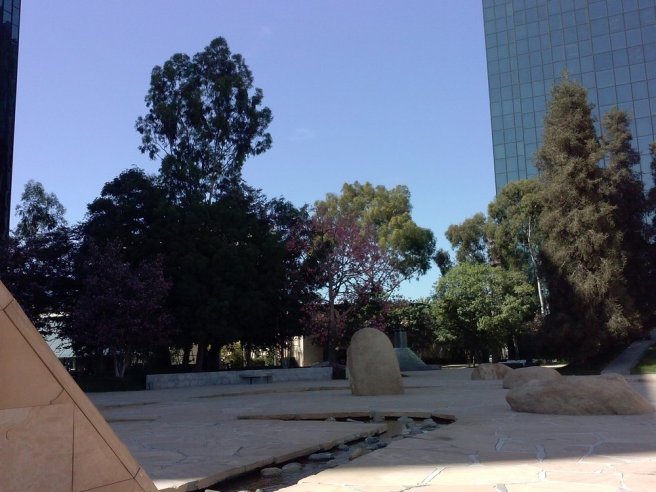
Being in Orange County, California Scenario obviously isn’t in Los Angeles County, but adding “Orange County” to the title of this piece would be as clunky as this sentence. California Scenario was created in 1980 by Isamu Noguchi for Henry Segerstrom, developer of Costa Mesa’s two main cultural hubs: the Segerstrom Center for the Arts and South Coast Plaza. The serene oasis is tucked between anonymous corporate highrises, the 405, a TGIFriday’s, and a parking structure — which just makes it feel that much more magical. It’s served by Orange County Transit Authority‘s 172, 211, and 464 lines.
EARL BURNS MILLER JAPANESE GARDEN (Long Beach)

The Earl Burns Miller Japanese Garden is a half-hectare Japanese Garden situated on the campus of California State University, Long Beach. It designed by Edward R. Lovell for Loraine Miller Collins in honor of her late husband Earl Burns Miller. Work began in 1980 and it was dedicated in 1981. I once helped set up a wedding there although I can’t remember who it was that was getting married! It’s served by Long Beach Transit lines 91, 92, 93, 94, 0121, 121, 171, and 173.
DONALD C. TILLMAN WATER RECLAMATION PLANT JAPANESE GARDEN (Sepulveda Basin)
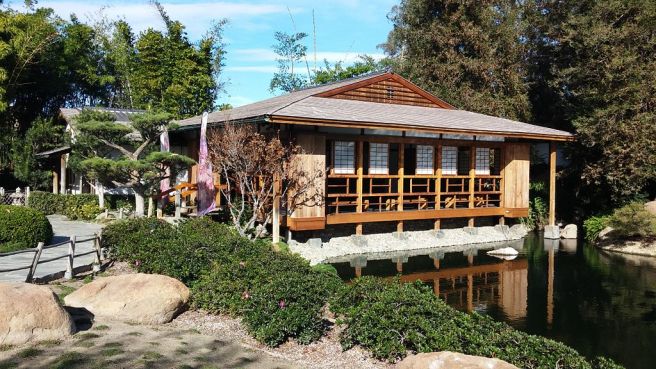
The 2.5-hectare Donald C. Tillman Water Reclamation Plant Japanese Garden was designed by Koichi Kawana and is actually three gardens, the Zen meditation karesansui, wet-strolling chisen, and the Shoin Building which includes a teahouse. Located in the Donald C. Tillman Water Reclamation Plant, its purpose is in part to get Angelenos to overcome their aversion to reclaimed water. Its design is modeled after the 19th century chisen-kaiyushiki gardens built for private estates. It was dedicated in 1984. It’s served by Metro’s 154, 164, 236/237, and Orange lines.
HSI LAI TEMPLE’S ARHAT AND AVALOKITESVARA GARDENS (Hacienda Heights)

Hsi Lai Temple (佛光山西來寺) is a Buddhist monastery in the built as the first overseas temple of Taiwan’s Fo Guang Shan sect. It was built from 1986-1988. The site includes several buildings: The Bodhisattva Hall, the memorial pagoda, the meditation hall, the dining hall, the Fo Guang Shan International Translation Center, and the main shrine. It also includes two gardens, the Arhat Garden (十八羅漢), the statues of which depict the Buddha’s first eighteen disciples, and the Avalokitesvara Garden (慈航普度), in which statues depict the bodhisattva, Avalokitesvara (Guan Yin), and her acolytes, the Four Heavenly Kings. It’s served by Foothill Transit’s 185 and 285 lines.
PINE WIND GARDEN (Torrance)
Torrance’s Pine Wind Japanese Garden (aka Shōfūen or 松風園) is located at the Torrance Cultural Arts Center. It was designed by the prolific (and aforementioned) Takeo Uesugi and dedicated, along with the Cultural Arts Center, in October of 1991. The garden includes two waterfalls, a koi pond, and a small amphitheater.
Pine Wind Garden is served by Torrance Transit’s 1, 2, 4x, and 6 lines.
GEORGE AND SAKAYE ARATANI JAPANESE GARDEN (Pomona)
The .53-hectare George and Sakaye Aratani Japanese Garden was designed, yet again, by Takeo Uesugi, who was a professor of landscape architecture at Cal Poly Pomona. The garden is landscaped with Asian plants including bonsai pine, sasa bamboo, and zoysia grass (as well as trees native to the Americas like jacarandas). The garden contains a large spring-fed pond (stocked with koi naturally), waterfall, fountain, bridges, and a small amphitheater. It was dedicated in June of 2011.
The George and Sakaye Aratani Japanese Garden is served by Foothill Transit’s 190, 194, 195, 289, 480, 482, and 486 lines.
Eric Brightwell is an adventurer, essayist, rambler, explorer, cartographer, and guerrilla gardener who is always seeking paid writing, speaking, traveling, and art opportunities. He is not interested in generating advertorials, cranking out clickbait, or laboring away in a listicle mill “for exposure.”
Brightwell has written for Angels Walk LA, Amoeblog, Boom: A Journal of California, diaCRITICS, Hidden Los Angeles, and KCET Departures. His art has been featured by the American Institute of Architects, the Architecture & Design Museum, the Craft Contemporary, Form Follows Function, Los Angeles County Store, the book Sidewalking, Skid Row Housing Trust, and 1650 Gallery. Brightwell has been featured as subject in The Los Angeles Times, Huffington Post, Los Angeles Magazine, LAist, CurbedLA, Eastsider LA, Boing Boing, Los Angeles, I’m Yours, and on Notebook on Cities and Culture. He has been a guest speaker on KCRW‘s Which Way, LA?, at Emerson College, and the University of Southern California.
Brightwell is currently writing a book about Los Angeles and you can follow him on Ameba, Duolingo, Facebook, Goodreads, Instagram, Mubi, and Twitter.
Art prints of Brightwell’s maps are available from Saatchi Art and 1650 Gallery. Other merchandise is available on Tee Public.
Click here to offer financial support and thank you!


OMG! They are so lovely and peaceful. We need more of this gardens in the city!
LikeLike
Eric – how can I find out which private gardens in Southern California were designed by Ryozo Kado? Are any extant? I grew up at St. Elizabeth’s in Altadena with his grotto/garden there and went to Manzanar to see his work being restored. I love your writing! Kay Toll.
LikeLike
An excellent question!
I would consider contacting the Little Tokyo Historical Society (http://www.littletokyohs.org/), Rafu Shimpo (https://www.rafu.com/), or the American Society of Landscape Architects (https://www.asla.org/). It’s entirely possible that no one at any of those places will know — but perhaps they’ll be able to point you in the direction of someone who does! If you find out about any in Southern California (especially in public spaces), please let me know.
…and thanks for the compliment and reaching out!
LikeLike